ABSTRACT
This research is based on Life and Earth Sciences (LES) textbooks (El Moufid in LES and El Massar in LES) used in Morocco for second year of college. It is aimed at showing the place of seismic risks education in LES. The methodology used is based on the content analysis of seismic risk management education in these manuals. The results show that this approach is more or less neglected in these textbooks; yet Morocco has made considerable progress in the field of natural risk management. Following the analysis of LES textbooks, implications of this research include the importance of introducing a risk management culture in textbooks and in the practice of teachers and learners.
Key words: Life and earth sciences, natural risk management, practice, seismic risks education, textbooks.
Morocco is a country exposed to many types of natural risks such as flooding, drought, earthquakes and tsunami, all of which affect numerous areas across the country. This study focuses on the manner of seismic risks infusion, specifically education to manage this risk. Thus, risk management education is the responsibility of everyone; however, schools play an important role in the formation, prevention and increased awareness. The general interest behind the present work is to contribute to the understanding of the role of textbooks in the life and earth sciences of the second year of college in teaching and learning seismic risk management education.
Textbooks are very important for both teachers and students as they are frequently used to support teaching and learning in many countries (Teters and Gabel, 1984; Sheldon, 1988; Sharp, 1999; Pepin and Haggarty, 2001). In the USA, Sheldon (1999) identified the main reasons: books are often the basis of a course and preparing classroom materials is difficult and time-consuming. They are recognized as one of the most effective factors for improving the quality of teaching by providing, if possible for each student, a tool that can accompany him directly in his learning both inside and outside the class, especially in states where the education system lacks resources (Gérard, 2010; Memaï and Rouag, 2017). In
the same perspective, confirms that the textbook is part of the teaching landscape of many countries, where it is a teaching and learning medium. For Gérard and Roegiers (1993), Benoit (1997), Bruillard (2005), Lebrun (2006), the textbook is both a special support for student learning, a guide for the organization of teaching as well as preparation of the course for teachers, and a way for students and families to support students in learning. However, this fundamental pedagogical tool is not a simple medium of transmission of knowledge, since by its content it participates not only in the instruction but also in the education ‘by the transmission, in a more or less explicit way, of models of social behavior, norms and values’ (UNESCO, 2008; 14). Many works highlight the importance of textbooks in the professional culture of teachers (Gérard and Roegiers, 1993).
Overtime, se
veral researchers have devoted research to the analysis of textbooks as shown by all known studies. In this context, most risk management education projects have favored strategies that encourage awareness, reflection and awareness rising to promote the empowerment of children and adolescents to better make decisions to protect themselves and their families to help others. Such decisions have individual and collective consequences for risks. Risk management education in this new paradigm, therefore, becomes an education of autonomy and responsibility towards others. As Meirieu (1993) and Margueron (1993) specifies, that of the individual autonomy will leave a collective dynamics. Dussaux (2015) also specifies that risk education consists of "making pupils aware that everyone must be attentive to their own safeguarding and can also contribute to that of others, to develop the idea that responsible and supportive behavior makes it possible to deal with risk more effectively. There is currently a strong interest in raising awareness and educating the public about disaster risk reduction (UN-SPIC, 2005; Federation International, 2009). In addition, risk management is the responsibility of everyone; meanwhile, risk management education starts at school as part of its complementary educational missions and essential in the training of individuals according to the DREAL of Midi-Pyrenees. The seismic risk is the probability, during a period of reference and in a given zone, of loss of the goods, the activities of production and the human lives, due to an earthquake. While managing a risk is preparing to face it to prevent its effects, risk management education can therefore be considered as an emerging field of education and a set of interventions that aims to inform, motivate and help learners voluntarily adopt life-friendly behaviors, to form a reasoned opinion on vivid questions where the intimate and social are strongly linked (Harzalli, 2013). Risk management education aims to intentionally place learners in a process of behavior and attitude change. To our knowledge, it appears that no Moroccan research has yet been done on the analysis of secondary school textbooks on education in natural risk management in general and seismic risk in particular. Earthquakes are among the most devastating natural disasters in the world. According to Cherkaoui and Asebriy (2003), seismicity in Morocco is moderate compared to other countries of the Mediterranean Basin such as Algeria, Greece, Italy or Turkey and the seismic activity in the North of Morocco is largely due to an intense Plio-Quaternary and current tectonic activity generated by the approximation of the two African-Eurasian lithospheric plates whose approach speed is of the order of 0.5 cm/year in the Strait of Gibraltar.
Enlightened by these problems, through our work on student conception of earthquake (Eddif et al., 2015), the fact that the official guidelines stipulate that the teaching of the LES is intended to make the student actor responsible for his learning, able to develop essential skills that he needs to adapt to the different circumstances of daily life, and by the fact that Morocco is a country exposed to many and varied risks which can have serious consequences in case of disasters.
For our part, we have opted for analysis of the content of the textbooks of the LES in use in Morocco in particular (Al-Moufid in LES – 2004 to 2018 Edition and Al-Massar in LES 2004 to 2018 Edition) from the perspective of education to the seismic risk management conveyed in these textbooks. It should be known that in Morocco, the teaching of LES begins from the secondary school level. The objectives of teaching LES are cognitive, methodological and educational. As for the Earth Sciences they are organized in two units during this cycle: the unit of external geodynamics treated in 1st year college and the unit of internal geodynamics treated in second year of college. The objectives are notably:
(2) To relate the movements of the lithospheric plates, and the geological phenomena that accompany them: earthquakes, magmatism.
(3) Master the knowledge and essential skills that will help them understand the world, make informed decisions, as well as act responsibly and critically in their daily lives.
This study attempts to answer the following sub-questions:
(1) What kinds of seismic risk management education content have been compiled in the textbooks of LES in Morocco?
(2) What are the elements and indicators of seismic risk management education for second year college in
Morocco?
Research design
The study focuses on elements and indicators of seismic risk management education for second year college in Morocco. We adopted the contrastive method, which is based on the comparison of several textbooks, in order to identify their structural differences and their similarities concerning a given theme. Indeed, we used one of the typologies proposed by Bernard et al. (2006) comparing several current textbooks dealing with the same content in the same country. This involved two steps as follows:
Stage 1
To study concept of earthquake from the documents in the textbooks of LES using a built-in analysis grid and to gather important information from these textbooks (Table 1).
Stage 2
To identify the elements and indicators of seismic risk management education for second year college in Morocco?
Textbooks
A content analysis was made of a corpus of our research which focuses on two second year of college textbooks: El Moufid in LES and El Massar in LES used in Morocco since 2004.
Analysis of textbooks
Analysis of textbooks makes it possible to analyze documents (text, pictures,...) and their occurrences in textbooks, and uses criteria and indicators to detect in the text the pedagogical style used in themes related to seismic risk management education.
The following summary (Table 2) gives a clear idea of the results arrived at from the analysis of the two LES textbooks. It presents the objectives and a number of pages relating to the earthquake chapter or pictures dedicated to the didactic transposition of this concept in Moroccan textbooks of the SVT of the 2nd year of Moroccan college. The iconographic content relating to the earthquake in Morocco has been mentioned in the two textbooks analyzed.
On the two manuals analyzed, the earthquake concept is part of the unity of internal geodynamics. The latter reinvests and details the geological phenomena that occur on the surface of our planet among others (volcanism, formation of mountain ranges, deformations ...) and the consequences that they may have on human populations.
Topics covered by the course about earthquake include, definition of the earthquake, seismic wave propagation, the processes that cause earthquakes and consequences, as well as the methodologies used by seismologists to analyze seismograms, distribution of earthquakes in the World and Morocco, Earth internal structure, and the relationships between earthquakes and plate tectonics. These data are presented in a clear and concise manner (activities - know-how) as part of the competency-based approach in teaching LES. They encourage the active participation of learners, are guided by a set of documents (text, pictures, ...) related to the objectives of the activity and are called to study carefully with reference to questions of each activity and to know and master the scientific vocabulary encountered during the activities. However, each manual offers a different organization of contents.
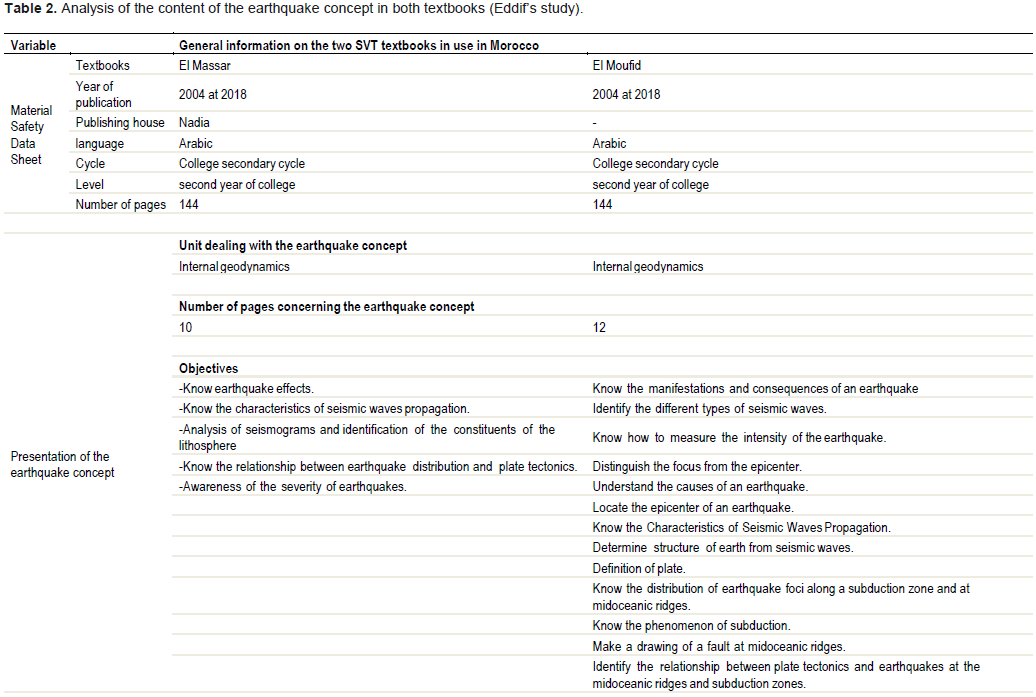
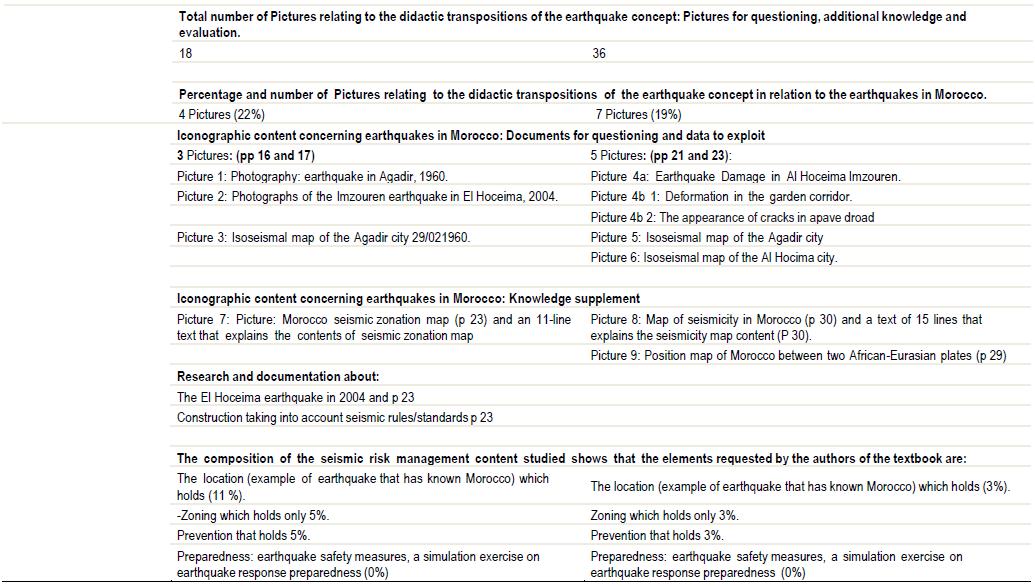
In addition to the differences in the number of pages relative to this chapter, the number of Documents regarding the way of handling this phenomenon is on both manuals. We noticed that the two manuals presented pictures of the earthquake experienced by Morocco in Agadir and El Hoceima for the textbook El Massar in LES (Pictures 1 and 2. p 16), the isoseismal map of 29th February 1960 Agadir earthquake (Picture 3. p 19), and only the El Hoceima earthquake for the textbook El Moufid in LES (Pictures 4a and 4b).
In the same vein, the textbook El Moufid presents: isoseismal map of the Agadir city (Picture 5. p 23) and isoseismal map of the Al Hocima city (Picture 6. p 23). Both earthquakes caused the loss of life, injury or human life disruption, property damage, social, economic, and political disruption, or environmental degradation.
In the part of the knowledge supplement related to the earthquake concept, the two textbooks present Morocco maps; one is Morocco seismic zonation map (page 23) with a text of 11 lines that explains the contents of seismic zonation map for the textbook El Massar in LES (Picture 7. p 23) and the other, a map of seismicity in Morocco (Picture 8. p 30) with a text of 15 lines which explains the contents of this map for the manual El Moufid in SVT. In addition to the manual El Moufid, we note the presence of a map that illustrates the position of Morocco between African plate and Eurasian plate (Picture 9. p 29).
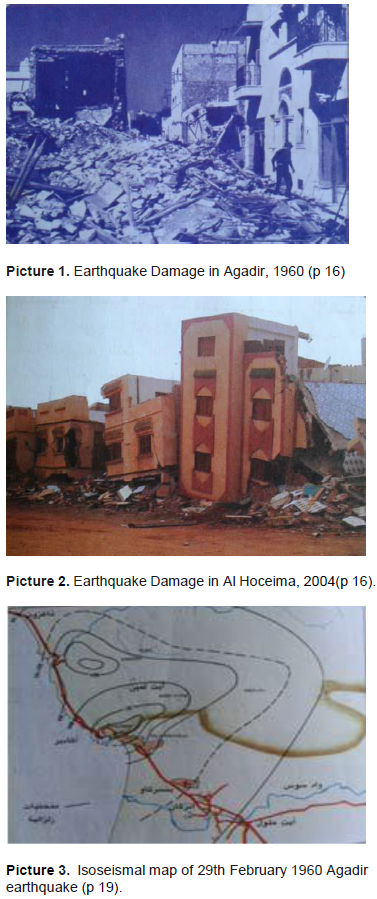
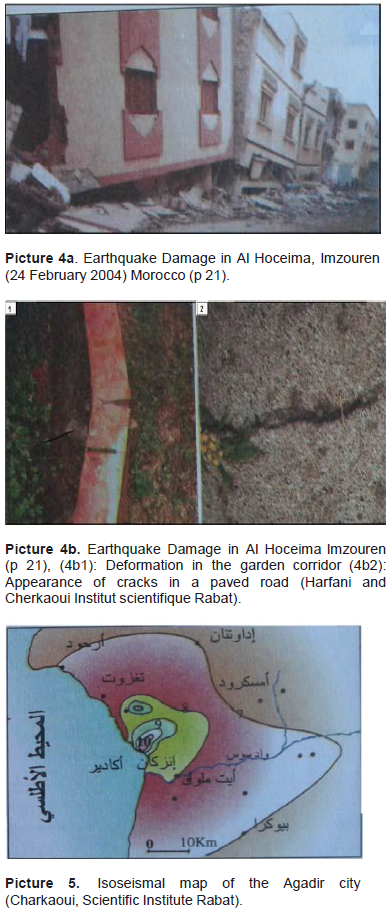
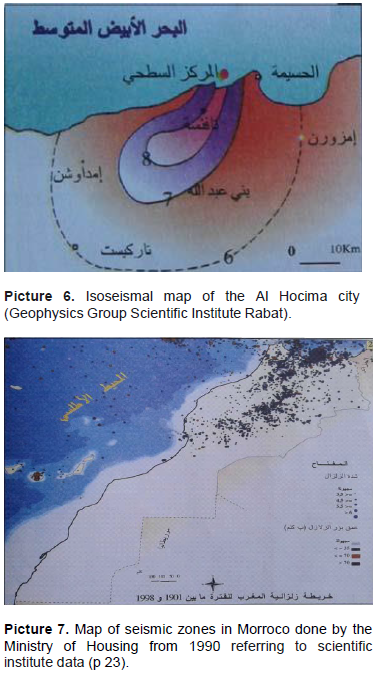

The manual EL Massar in SVT devotes in this part of the supplement of knowledge a sentence "Construction taking into account the rules/seismic standards" (page 23). It therefore engages learners and teachers in investigation and realization activities based on research and documentation about seismic construction. As a result, the target population will participate in the construction of their own seismic building knowledge and profit from their curiosity and satisfaction. We will add that the two manuals do not report safety and seismic risk prevention instructions anywhere, although this is an important component of the awareness campaign and the prevention of seismic risk.
The composition of the seismic risk management content studied shows that the elements requested by the authors of the textbooks are:
(1) The location (example of earthquake that has affected Morocco) which holds 3% in the textbook El Moufid and 11% in the textbook El Massar.
(2) Zoning which holds only 3% in the textbook El Moufid
and 5% in the textbook El Massar.
(3 Prevention that holds 3% in the textbook El Moufid and 5% in the textbook El Massar.
(4) Preparedness: Earthquake safety measures - a simulation exercise on earthquake response preparedness 0%.
As a result of the above, we note therefore that despite the supplemental part of the course which presents pictures of seismic maps of Morocco, and challenges in the case of the textbook El Massar in LES, the learners of a research on earthquake-resistant constructions, as well as pictures or texts related to earthquake risk management education are almost absent in the two LES textbooks. However, this reduced number of pictures and texts proposed in the supplemental part of the course, to build knowledge, may or may not be used by teachers as well as learners and by engaging learners in a literature search to develop their information culture- not guided by precise documentation, and does not facilitate the active participation of learners in their learning in relation to seismic risk management education.
We also add that in the textbook studied, what is asked by the authors is mainly to lead students to discover what are earthquakes (definition, causes, characteristics: epicenter, hypocenter, types of seismic waves, magnitude, intensity.
..), from the risks they pose to the populations, from the exploitation of documents, and to consider the seismic activity as a set of phenomena reflecting an internal activity of our planet within the framework of plate tectonics.
All this testifies to the negligence in the Moroccan textbooks of the LES of the secondary school education seismic risk management while Morocco has presented progress in the system of actions for the prevention of natural disasters (evaluation of risks, forecasting, prevention, management, rehabilitation, feedback, training in risk culture.
..) (Constitution of July 2011, National Strategy for Environmental Protection and Sustainable Development, Water Resources Management Strategy). Actions in education for this management should also be based on management that also seeks to develop informed, autonomous learners; prepared for seismic risk and able to behave appropriately during an earthquake to integrate into the collective crisis organization.
The tasks of this preparation are the realization of plans and training through exercises. Such an education calls for an improvement of these textbooks in this concept as in the case of countries at seismic risk.
A content analysis for suitability of elements and indicators of seismic risk management education in the textbooks of the life and earth sciences of the second year of college of Moroccan, show that secondary school textbooks in the second year of the Moroccan secondary cycle, used by both teachers and learners for more than 13 years, emphasize a mastery pedagogy that provides a great deal of knowledge scientists relating to the concept of earthquake (its origin, types of waves and their interest in the determination of the internal structure of the earth, global distribution of earthquakes, ...), but ignoring a sensitive subject that of the practice of education in seismic risk management. It appears that the content of the two textbooks El Moufid and El Massar shows no signs of renewal over the years (2004 to 2018).
As a result, these manuals revealed serious management and risk prevention gaps. All this testifies to the negligence and the total absence of information (safety instructions and prevention of seismic risks) and practical activities of the good preparation of the learners (exercises of prevention in the schools) to react appropriately to the risks and to avoid panic during the first shock and limit the dangers of an earthquake. These manuals therefore do not fully fulfill their function in terms of risk management. This could represent real obstacles, the extent to which learners are unable to cope appropriately with an unforeseen event that disrupts their traditional rules of life. However, the prevention of natural hazards including earthquakes has become a major concern of various stakeholders, including the departmental departments, the private sector and insurance companies. This interest is rooted in the High Directions of His Majesty the King on many occasions. To this end, Morocco has made progress in the system of actions to prevent natural disasters (Constitution of July 2011, national strategy for environmental protection and sustainable development, water resources management strategy ...). Thus, numerous periodic reports in 2007 to 2008, 2009 to 2010 and 2011 to 2013 have been produced. These focused on the progress made in disaster prevention and management, as well as the challenges to be met in implementing risk reduction actions at the national level.
This study is suitable for those interested in seismic risk management education in the textbooks and seismic risk research as well as a more general audience of seismologists, geophysicists and Earth scientists. It is also useful for authorities responsible for public safety and natural hazard mitigation plans and for insurance companies and conceptual textbooks and teachers.
All of the analyses reveal that the seismic risk management education in the textbooks content input has not received the due attention. So, these results pave the way for a set of reflections to be carried out which includes:
(1) Make available to teachers and learners an updated textbook periodically taking into account the particularities of the regions, and support on such textbooks is a guarantee of success for the teaching-learning of the LES.
(2) Integrate into school curricula, including all cycles, seismic risk management education "simulation exercises" to ensure learning and behavioral learning for all learners and teachers in preparation for an event of real alert.
(3) Structurally improve most school buildings and develop school plans for seismic risk management,
(4) School authorities should take precautionary measures to avert risks to student’s earthquake and safety,
(5) Establish, in schools, seismic risk education clubs and working groups, and train them as possible preparation for risk reduction. This implies that seismic risk management education in schools should be designed according to an interdisciplinary logic capable of preparing students to cope with uncertainties and to overcome any obstacles to risk. It would therefore be interesting to consider also the analysis of geography textbooks and scientific awakening.
(6) Make better communication of seismic risk management education information an urgent priority: Clear communication throughout the teaching cycles, is critical for successfully mitigating disaster risk.
(7) Prevention measures need to be taken into consideration in the Al Hoceima and Agadir areas, and to a degree in other areas of Morocco, which show less significant seismic activity.
(8) Foster multidisciplinary, multi-institutional, and multi-sectoral collaboration at all levels, and promote a culture of protection against seismic risks in risk areas, "distribute guides and posters safety instructions and seismic risk prevention, as well as develop public awareness and education activities to reduce seismic risks".
The authors have not declared any conflict of interests.
REFERENCES
|
Benoit F (1997). Guide d'évaluation des manuels scolaires. Ministère de l'Education Nationale .1ere Edition, 1er trimester.
|
|
|
|
Bernard S, Clement P, Carvalho G (2006). Méthodologie pour une analyse didactique des manuels scolaires, et sa mise en œuvre sur un exemple. In: Lebrun J. (ed.), Le manuel scolaire d'ici et d'ailleurs, d'hier à demain, Actes du Colloque de Montréal mars.
|
|
|
|
|
Bruillard E (2005). Manuels scolaires, regards croisés. Caen: SCEREN-CRDP.
|
|
|
|
|
Cherkaoui T, Asebriy L (2003). Le risque sismique dans le Nord du Maroc. Trav. Inst. Sci.Rabat, sér. Géol Géogr. phys. 21:225-232.
|
|
|
|
|
Dussaux M (2015). Risques, citoyenneté et éducation. Actes du colloque "les éducations à..." levier (s) de transformation du système éducatif?. Nov 2014 Rouen, Mont Saint Aignan, France 2015. pp. 144-158.
|
|
|
|
|
Eddif A Touir R, Majdoubi H, Larhzil H, Mousaoui B, Ahmamou M (2015). The Initial Conceptions for Earthquakes Phenomenon for Moroccan Students of the First Year Secondary College. Journal of Education and Practice. ISSN 2222-1735 (Paper) ISSN 2222-288X 6:18.
View.
|
|
|
|
|
Fédération internationale des Sociétés de la Croix-Rouge et du Croissant- Rouge, Stratégie 2020. Genève: Fédération internationale, 2009.
|
|
|
|
|
Fédération internationale, (2009). Sensibilisation et éducation du public à la réduction des risques de catastrophe : un guide.
|
|
|
|
|
Fédération internationale des Sociétés de la Croix-Rouge et du Croissant- Rouge, Stratégie 2020. Genève: Fédération internationale, 2009.
|
|
|
|
|
Fédération internationale des Sociétés de la Croix-Rouge et du Croissant- Rouge, Cadre pour la sécurité et la résilience des communautés face aux risques liés aux catastrophes. Genève: Fédération internationale, 2009.
|
|
|
|
|
Gérard FM (2010). Le manuel scolaire, un outil efficace, mais décrié. Education et Formation Manuels scolaires et matériel didactique, 292:13-24.
|
|
|
|
|
Gérard FM, Roegiers X (1993). Concevoir et évaluer des manuels scolaires. Bruxelles: De Boeck-Wesmäel. Revue des sciences de l'éducation 20(2):399-399.
Crossref
|
|
|
|
|
Harzalli F (2013). L'éducation à la gestion des risques naturels dans le manuel de géographie de la 1ère année secondaire en Tunisie : analyse didactique et propositions. Insaniyat / ﺕﺎﻴﻧﺎﺴﻧﺇ, 60-61:159-179.
Crossref
|
|
|
|
|
Laaraj A, El Asri A, Takhalouicht M, Andalousi MSR, Ait Belhaj I (2004). El Massar in LES.Edtions 2004, Publishing house Nadia.
|
|
|
|
|
Lebrun M (2006). Le manuel scolaire - Un outil à multiples facettes. Montréal Collection éducation recherche, 20 : Presses de l'université du Québec. ISBN 2-7065-1406-4.
|
|
|
|
|
Margueron P (1993). Travail autonome, pédagogie de l'autonomie, deux décennies, réflexions et bilans in Enseigner l'histoire et la géographie; un métier en constante rénovation, AFDG, Mélanges offerts à Victor et Lucile Morbeau. 8 Voir l'article auquel nous nous sommes déjà référé. Esquisse d'une théorie de l'autonomie, paru dans le journal des instituteurs.
|
|
|
|
|
Meirieu P (1993). Esquisse d'une théorie. JDI n°9mai Au-delà de l'outil pédagogique, l'objet politico-social, Éducation et socialisation. Consulté le 22 Mars 2019.
Crossref
|
|
|
|
|
Newton DP, Newton LD (2007). Could elementary mathematics textbooks help give attention to reasons in the classroom? ESM 64 1 january 2007.
Crossref
|
|
|
|
|
Memaï A, Rouag A (2017). Le manuel scolaire : Au-delà de l'outil pédagogique, l'objet politico-social », Éducation et socialisation. Consulté le 22 Mars 2019.
Crossref
|
|
|
|
|
Pepin B, ve Haggarty L (2001). Mathematics textbooks and their use in English, French and German,classrooms. Zentrablatt fur Didaktik der Mathematik 33:158-175.
Crossref
|
|
|
|
|
El Moufid in LES (2004). Edtions Publishing house Dar Attaqafa Sharp A (1999). Aspects of English medium textbook use in Hong Kong. New Horizons in Education 40:93-102.
|
|
|
|
|
Sheldon LE (1988). Evaluating ELT textbooks and materials. ELT Journal 42:237-246.
Crossref
|
|
|
|
|
UN-SPIC (2005). Stratégie internationale de prévention des catastrophes des Nations Unies, Cadre d'action de Hyogo 2005-2015 : Pour des nations et des collectivités résilientes face aux catastrophes. Kobe, Japon: ONU-SPIC, 2005.
|
|
|
|
|
Teters P, Gabel D (1984). 1982-83 Results of the NSTA survey of the needs of elementary teachers regarding their teaching of science. Washington: National Science Teachers Association (ERIC Document Reproduction Services No. ED 253 398).
|
|
|
|
|
UNESCO (2008). Comment promouvoir l'égalité entre les sexes par les manuels scolaires ? Guide méthodologique à l'attention des acteurs et actrices de la chaîne du manuel scolaire. Paris, UNESCO.
|
|